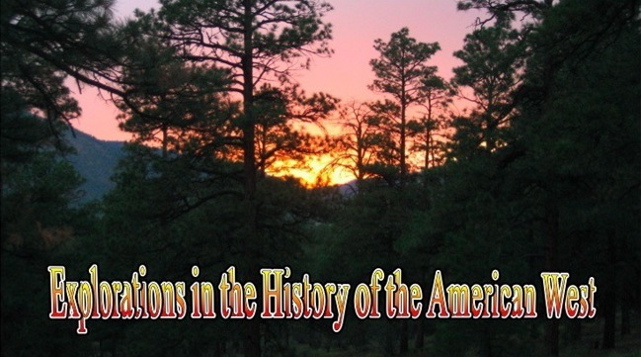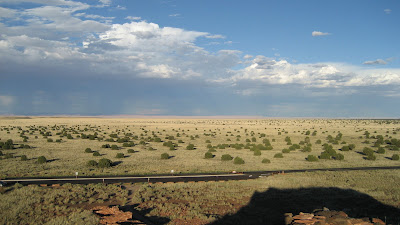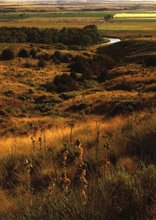I have been assigned the task of writing a historiographical essay in my environmental history class. One of the most interesting research areas of this type of history is Native Americans. Native Americans and natural resource use, Native Americans and National Parks, etc. There are many topics of study for environmental history and Native Americans. I have decided to write my paper on natural resource use amongst the Plains Indians by examining the most
relevant research on the topic. One of the goals of this essay will be to determine if there is the possibility for a dissertation in each of our selected fields of interest. I have a very good feeling about this project. Here is an example of what I have been doing for this project. I am basically outlining/reviewing articles and monographs on this topic. I have completed two of these in the last three days. Here they are for those interested:
Dan Flores, Bison Ecology and Bison Diplomacy: The Southern Plains from 1800 to 1850. The Journal of American History, Vol. 78, No. 2. (Sep., 1991), pp. 465-485.
The research question guiding Dan Flores in this article is: Within little more than half a century, the Comanche and other tribes of the Southern Plains were routinely suffering from starvation and complaining of shortages of bison. What happened? To answer this question, Flores uses the longue durée approach of the Annales School. He examines the demographic and ecological history of the region before the year 1800 by discussing the movements of several tribes into the Southern Plains region as well as the developmental history of the American bison. What Flores is also searching for, a central issue raised during his research, is the question of whether or not the Southern Plains tribes were able to create a dynamic ecological equilibrium between themselves and the vast bison herds that grazed the Plains.
The historiography of bison ecology that Flores’ work disproves in many ways is the long held belief that Indians did not live out of balance with nature; Flores cites the work of Frank Roe, The North American Buffalo and assertions made by that author to the contrary. The history of the Southern Plains needs to be understood in an environmental context; and to do this, Flores cites several factors in the shaping of this region prior to 1800. Cycles of drought, the effects of hunting in the Pleistocene era, and the arrival of Euro-Americans all affected the development of the ecology of the Southern Plains in certain ways. Cycles of drought and rain produced the grasslands that bison fed on; a period of plentiful rainfall produced a Plains area that was attractive to groups of Northern Plains tribes who began to make their way to the area beginning in the 16th century. Drought could also cause bison to leave the Plains and travel to areas with abundant water sources. There are many causes and effects associated with this ecological factor. Hunters in the Pleistocene era are supposed to have killed off the mammoth bison. Supposed evolutionary adaptations on the part of the present day bison to grow smaller, produce offspring faster, and to reach sexual maturity quicker all helped the animal increase its population. The arrival of Euro-Americans meant many changes, but Flores specifically cites the changes that took place in trade relationships. The patterns, the goods and the intensity of trade were all changed by Euro-Americans.
Flores argues that bison ecology is much more complex than we have been led to believe, which leads to a great deal of misunderstanding. Several key points need to be made: there have been periods (decades or even centuries) when bison seemed almost absent from the Plains region and calculations of bison population have generally tended to be greatly exaggerated. According to Flores the reason that bison have been almost absent from the Plains in the past has a great deal to do with the aforementioned periods of drought. The only reason this is brought up here has to do with Flores’ discussion on the natural ecology of the Plains. He wants to get at the root of what he terms to be the “carrying capacity” of the land to determine how many bison the land could have sustained. Estimates for the population of the bison have ranged as high as 60 or 100 million buffalo throughout the entire Great Plains region. Flores disagrees with this estimate. Flores feels that the land could have supported no more than 8 or 9 million bison at any time. Carrying capacity could swing back and forth from decade to decade.
There are important impacts on Comanche culture as a result of their adoption of the buffalo horse culture mentality. As Flores states in this article, becoming buffalo horse culture practitioners caused the Comanche and other tribes to lose a great deal of their tribe’s accumulated plant lore (in the case of the Comanche the loss of plant lore was nearly 2/3 of what they had acquired). Comanche women suffered a loss of status (something almost all Plains women suffered during the transition) as they lost their role of cultivators of the soil, supplying sustenance for their people and began to prepare hides almost constantly.
By making a break with their Shoshone traditions of polyandrous marriages and infanticide, the Comanche demonstrated agency in increasing their tribal population. This would eventually exacerbate food shortages and drought conditions. The choice to adopt horse technology and to live in semi-sedentary villages enabled the Comanche to dominate the Southern Plains. The other tribes that called this region home at the time of the Comanche’s arrival, most notably the Apache, had adopted permanent village settlements that were easy for the Comanche to find and destroy, thus affirming their control of the land.
The Comanche were the dominant tribe on the Southern Plains until the arrival of other buffalo horse culture groups, especially the Cheyenne and Arapaho but also the Kiowa. Competition and fighting for land use and access to bison herds among these four tribes had the effect of creating buffer zones at the nexus between territories. In these buffer zones, bison and other animals were left relatively unmolested until peace between the tribes was settled and these areas were actively hunted out.
To answer his questions regarding how the bison herds were no longer a reliable source of food as well as whether the Indians on the Southern Plains adopted an ecological strategy regarding the use of this important resource, Flores first delves into all of the causes for the decrease in bison population. First among the causes of this environmental change was a growing participation in the market economy on the Southern Plains by members of the Cheyenne, Arapaho, Kiowa and later Comanche tribes. When Indians realized the importance of the bison as a trade good, they began to capitalize on it by increasing their kills. At first this impact was not felt on the bison herds, but when the other causes are analyzed and determined, it becomes apparent that increased killings had a dramatic impact later. What are the other causes Flores discusses?
The causes for the decline in bison populations are directly linked to the ecological changes that took place on the Plains beginning with the arrival of Euro-Americans. The first of these ecological alterations is the introduction of the horse and the subsequent competition for water and grass between horses and bison. Bovine diseases such as anthrax, brucellosis, and tuberculosis likewise caused many deaths among the bison herds. Wolf predation was a major factor for many centuries on the Plains; some tribes said that wolves killed about 3 or 4 out of 10 newborn bison calves. The climactic cycle, which first drew the Comanche to the Southern Plains, was also a factor in the demise of the bison, as beginning in 1846 terrible droughts ravaged the region. Pressures brought on by droughts could normally be combated by bison migrating to peripheral areas of the Great Plains where water was plentiful; however, the final ecological factor, increased pressure during the period 1825-1850 on the part of New Mexicans, American traders demanding more hides, and eastern Indians transferred to Indian territory in present day Oklahoma, blocked the herds from reaching those lands. So they remained on the Plains and suffered the effects of drought and starvation.
So to answer his question regarding whether or not the Plains Indians developed an ecological strategy to conserve the bison population, Flores states that the Plains tribes only wanted to keep other tribes from hunting the bison; that was the only strategy they developed. There is a reason for the short sightedness of the Indians, though. It is Flores’ belief that the religious views of the Southern Plains Indians actually prevented them from conserving bison due to the fact that bison were supposed to be supernatural creatures. There was an empirical basis to this belief, as many Indians had been to the Staked Plains region of west Texas to see bison emerging from caves at the beginning of spring as they made their way out onto the Plains. After witnessing this spectacle, many Indians came to believe that bison were created underground each year before the hunting season, made specifically for the Indians.
Richard White, The Winning of the West: The Expansion of the Western Sioux in the Eighteenth and Nineteenth Centuries, The Journal of American History, Vol. 65, No. 2. (Sep., 1978), pp. 319-343.
In this article, Richard White is arguing that the traditional view of Plains Indian warfare needs to be reexamined due to the fact that earlier historians focused almost exclusively on what has been called the individual warrior stereotype. White believes that Native American warfare was dynamic; wars were fought for economic and social reasons, not simply for individual honor. A central theme of this work is the development of the use of the American bison by the Lakota people. Efforts to obtain this natural resource caused many wars and battles between the Lakota and other Plains Indian tribes from the early 18th century to the end of the 19th century.
White organizes this article into three periods of Lakota expansion onto the Plains. The bison occupied a unique position within Lakota culture and economy in each of those periods of expansionism, and in fact generally was a primary cause for said expansion. The three periods of expansion were as follows: the first period witnessed the Lakota leave their tribal homeland in present day Minnesota and arrive in the prairie region east of the Missouri River. During this period, the Teton Lakota were primarily interested in hunting beaver for trade with Europeans for guns and other metal goods. This period of expansion was in many ways marked by cultural and economic dilemma. The Lakota were torn between hunting the bison for sustenance or hunting the beaver for economic gains, that is trade goods, from Europeans. Eventually the Teton would make the decision to primarily hunt bison while the Yankton and Yanktonai would continue the beaver hunt/trade east of the Missouri River.
The second stage of expansion onto the Plains took place beginning in the late 18th century and occurred for several reasons. One reason was the fact that the Lakota had over hunted the prairie lands east of the Missouri River; few if any bison or beaver could be found in that region by this time. A second reason was that the Missouri River tribes, whose presence had held the Lakota back from entering the Plains, began to die off in massive numbers due to the arrival of epidemic diseases brought by traders. With the deaths of so many of their former enemies, the Lakota began to expand westward. A third reason for moving onto the Plains, was to hunt bison for the European trade market. When Europeans began offering trade goods in exchange for bison robes, the Lakota actively decided to participate in the trade process.
The third period of expansion took place during the first decades of the 19th century and again was marked by an increasing need for more hunting lands as bison were pushed by hide hunters to the north and west of the Missouri River. White says that the three main reasons for Lakota expansion during this period were the following: increasing demand for bison and horses, the declining and retreating bison populations (moving to the north and west), and attempted domination of the sedentary villagers (Arikara). The Lakota followed the bison and were able to continue their dominance of the Great Plains due in large part to their expanding population base. Throughout their time on the Plains the Lakota were one of the only tribes whose population grew; this had a great deal to do with the fact that the Lakota lived in small bands and were not wiped out by epidemic diseases the way the Arikara were, for example. It also had a lot to do with the continuous stream of eastern Sioux Indians moving out onto the Plains to be with their Lakota relatives. What is ironic is that the added population of the Lakota put a larger and larger strain on the bison population, requiring the Lakota to keep expanding and acquiring more land.
The need for more horses is understandable when one considers the harsh Plains winters. In this environment, many horses would die during the winter; raids were required to replace lost horses. The final cause of expansion, that of dominance over the sedentary villagers, was based on controlling their access to natural resources, trading partners, hunting territory, basically blocking those people from fulfilling their own economic needs. In fact the Lakota required the Arikara to fulfill the economic role of women as part of their subservient position.
White discusses the areas of land at the nexus of tribal domains, what Flores referred to as buffer zones, and he believes that these western buffer zones between Lakota land and the lands of other tribes, especially the Crow and Shoshone, were major factors in the minds of the Lakota for moving farther to the west, to the Platte River valley and beyond during this third period of expansion.
The significance of White’s article for environmental history is that it lays out an argument for understanding Plains warfare in the context of a struggle for natural resources. The question must be asked, in what way, if any, did the Lakota attempt to conserve resources for the future? The answer is that they didn’t. If they had any type of strategy in the conservation sense I would say that it was similar to that of the Comanche. They wanted to hunt the bison to the extent that it was needed in terms of their cultural and economic values, but to the exclusion of all others. They wanted to control other tribe’s access to the herds and they wanted to keep Americans away from their herds. Other than that they would kill enough bison to eat and for hides to trade for goods like guns, knives and other metal items.
 Oldham Trail is not a particularly difficult trail, at least we didn't think so, but we have been walking an awful lot lately (about 33 miles a week on average). There were a couple of up and down sections of the trail but nothing akin to the experience we had climbing Mt. Elden.
Oldham Trail is not a particularly difficult trail, at least we didn't think so, but we have been walking an awful lot lately (about 33 miles a week on average). There were a couple of up and down sections of the trail but nothing akin to the experience we had climbing Mt. Elden. And another:
And another: Both of these caves are some distance off the path. In the case of the cave pictured above, it is the same very long cave system in two photos. We had to climb the "boulder mountain" a distance of about 20 feet up to gain access to these caves. I won't lie, we were both scared shitless that there would be sleeping bears in these caves. There were shapes that we couldn't identify, so who knows.
Both of these caves are some distance off the path. In the case of the cave pictured above, it is the same very long cave system in two photos. We had to climb the "boulder mountain" a distance of about 20 feet up to gain access to these caves. I won't lie, we were both scared shitless that there would be sleeping bears in these caves. There were shapes that we couldn't identify, so who knows.

 In this photograph of Rachel, you can see what I mean by "the boulder mountain". Along the base of Mt. Elden there are several of these formations that look like huge piles of boulders. You can climb through these and explore the cave systems that are found everywhere throughout the area.
In this photograph of Rachel, you can see what I mean by "the boulder mountain". Along the base of Mt. Elden there are several of these formations that look like huge piles of boulders. You can climb through these and explore the cave systems that are found everywhere throughout the area. 






















































